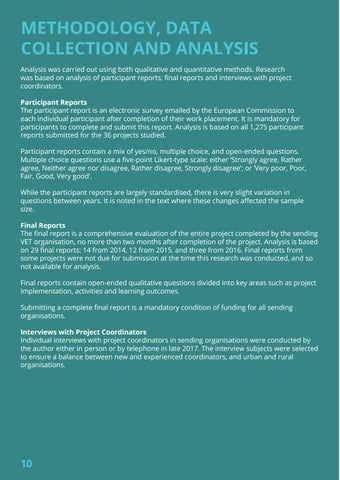METHODOLOGY, DATA COLLECTION AND ANALYSIS Analysis was carried out using both qualitative and quantitative methods. Research was based on analysis of participant reports, final reports and interviews with project coordinators. Participant Reports The participant report is an electronic survey emailed by the European Commission to each individual participant after completion of their work placement. It is mandatory for participants to complete and submit this report. Analysis is based on all 1,275 participant reports submitted for the 36 projects studied. Participant reports contain a mix of yes/no, multiple choice, and open-ended questions. Multiple choice questions use a five-point Likert-type scale: either ‘Strongly agree, Rather agree, Neither agree nor disagree, Rather disagree, Strongly disagree’; or ‘Very poor, Poor, Fair, Good, Very good’. While the participant reports are largely standardised, there is very slight variation in questions between years. It is noted in the text where these changes affected the sample size. Final Reports The final report is a comprehensive evaluation of the entire project completed by the sending VET organisation, no more than two months after completion of the project. Analysis is based on 29 final reports: 14 from 2014, 12 from 2015, and three from 2016. Final reports from some projects were not due for submission at the time this research was conducted, and so not available for analysis. Final reports contain open-ended qualitative questions divided into key areas such as project implementation, activities and learning outcomes. Submitting a complete final report is a mandatory condition of funding for all sending organisations. Interviews with Project Coordinators Individual interviews with project coordinators in sending organisations were conducted by the author either in person or by telephone in late 2017. The interview subjects were selected to ensure a balance between new and experienced coordinators, and urban and rural organisations.
10 10
